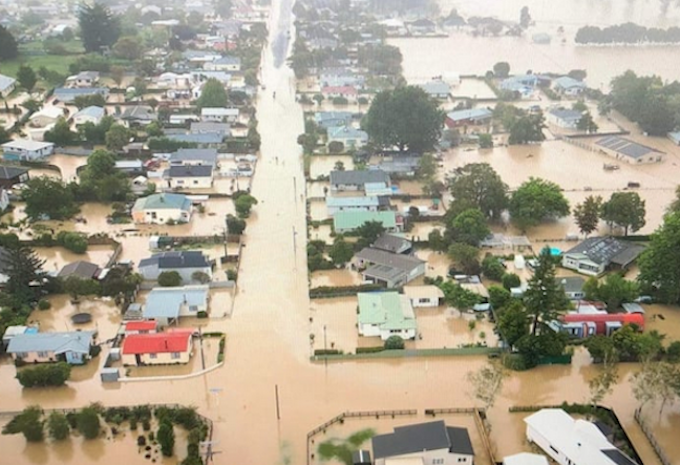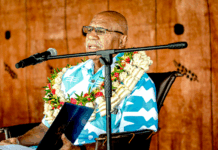
By Amy Williams, RNZ News journalist
Aotearoa New Zealand’s largest insurer says 20,000 homes across the country are at severe risk of flooding and it is in talks with government about where flood-damaged houses should be written off for good.
IAG is part of an advisory panel that is helping the government with managed retreat legislation.
Those in regions hard hit by Cyclone Gabrielle, who want to walk away from their flood-damaged homes, need answers, among them Peter Johnstone.
He stood on the roof of his house the night Pakowhai flooded, and felt creaking and groaning and feared the roof would collapse. Two weeks on, he was shocked to learn the insurer planned to fix his home.
“The people that are there to assess are sort of saying, ‘Oh no, this is rebuild, this is a refix’, refix is the word they’re using,” he said.
“I said, ‘You be kidding me, the whole bloody lot could be condemned, Pakowhai should be condemned’. Every house in Pakowhai is munted.”
He is 75 and together with his wife has lived on the four hectares for three decades.
‘Daunting for me’
“It’s just daunting for me — I’m not scared of hard work but it’s daunting for me. How on earth will I get that place back up?”
They want out and have commissioned an independent engineer to determine if the yellow-stickered home is, in fact, a write-off.
Also in Pakowhai, Keith Gore and his wife live between the two rivers and also want out. An assessor visited this week.
“The assessor is out of Christchurch and he’s been in the game for 43 years,” Gore said.
“He did the Christchurch earthquake, floods at Taeri, floods at Greymouth and one other, and when he walked in our house he said: ‘This is the worst I’ve ever seen’.”
He was not impressed that the insurer wanted to scope costs to rebuild the silt-ridden house.

RNZ talked to three different councils in the East Coast — none would say which areas should be vacated for good.
Quick decisions needed
Minister of Finance Grant Robertson said on Sunday decisions need to be made quickly on whether some places should be rebuilt the way they were — before money and resources were wasted in areas that would need to be abandoned.
IAG chief executive Amanda Whiting said the insurer had maps of areas at high risk of flooding, and was sharing these with officials.
“They vary and we’ve got to do a bit more mapping yet because we’ll have to agree on the parameters that deem those high flood risk zones. But we do have a lot of that mapping available and we’ll share that with government and other stakeholders,” she said.
IAG’s modelling shows 1 percent of homes — around 20,000 around the country — are at risk of severe flooding.
Until there was certainty over areas for managed retreat, Whiting said homeowners caught in limbo should let their insurer know if they want to relocate.
“Talk to us. As we start to get a bit of a sense of those people who are wanting to retreat that will help us with the government on a plan.”

In central Hawke’s Bay, around 200 homes flooded in Waipawa on the night of the cyclone.
Bryce Fergusson was among locals who ran to safety when the river’s stopbank overflowed. Even so, he wanted to rebuild.
“I’m pretty sure it’ll be in hot demand living up on the hill now but we love our land. We’re really hoping this is a once in a lifetime experience.”

Central Hawke’s Bay mayor Alex Walker said there was no urgency to relocate entire communities in Waipawa.
“There’s not a clear locality within central Hawke’s Bay district where we would be talking about urgent withdrawal of property but there might be some isolated pockets of one or two properties where there is a requirement for that conversation about where and how people may rebuild.”

Hastings mayor Sandra Hazlehurst said residents were already making decisions about whether to stay or go, and needed certainty — especially those in 680 yellow-stickered homes.
“We pretty quickly need to sit down with our affected communities, government, insurance council and banks and work out what this process will look like to give them some certainty about next steps and a timeframe.”
Up the coast, Gisborne District Council chief executive Nedine Thatcher Swann said it would likely to take time, and Māori landowners needed to be consulted.
“We’re talking about people who are deeply ingrained, who have whakapapa here.
“So it’s not a matter of simply, you know, redesigning and rebuilding and relocating. It’s a long journey that we need to work closely with our hapū and iwi on.”
For those in limbo like Peter Johnstone, it was a waiting game.
“I’m really worried about what’s around the corner, what do we accept. The government should be saying this is worse than an insurance problem, this is a major and we don’t want that little town to be there any longer.”
This article is republished under a community partnership agreement with RNZ.












































